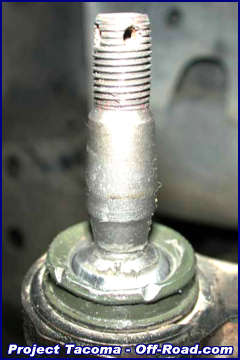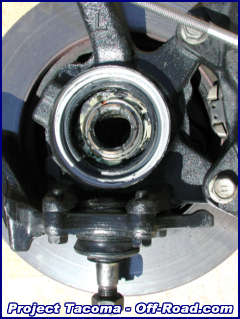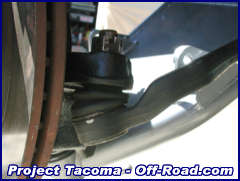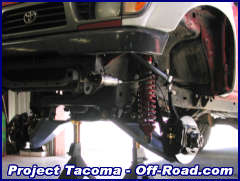
 Total Chaos Fabrication has developed a line of desert racing inspired long travel front suspension systems that are far more performance-oriented than any of the mainstream drop-bracket type lift kits. The Total Chaos 4WD/Prerunner Tacoma long travel setup provides 14"of vertical wheel travel; that's more than double the suspension travel of a stock Tacoma truck, and is achievable retaining the use of 4WD!
Total Chaos Fabrication has developed a line of desert racing inspired long travel front suspension systems that are far more performance-oriented than any of the mainstream drop-bracket type lift kits. The Total Chaos 4WD/Prerunner Tacoma long travel setup provides 14"of vertical wheel travel; that's more than double the suspension travel of a stock Tacoma truck, and is achievable retaining the use of 4WD!
There is performance and ride quality to be gained from this type of suspension far beyond the bullshit drop bracket IFS lift kits out there. Why lift your truck more than you need to? Why only gain additional tire clearance and a minimal increase in performance off-road? Why modify a perfectly good truck to ride stiff and handle poorly? Total Chaos suspensions are built to actually perform off-road and by the same modifications, IMPROVE the handling and ride quality of your truck on-road. Here it is in a quick wrap-up: fit larger tires with minimal lift, gain additional ground clearance, increase suspension travel, significantly improved performance on and off road.
The Tacoma installation can easily be completed in a driveway over a weekend and is almost entirely bolt-on except for a couple tabs (included) that need to be welded in-place to mount the limiting straps after the installation if finished. Ride height is adjustable from a minimum of 3" lift over stock and has been designed to clear 33" tires on full compression of the suspension.
This article is not intended to be an instructional step-by-step installation for the novice mechanic because although the modifications being discussed are fairly straightforward, if you are not familiar with the concepts and mechanics of the parts involved, you should probably leave any modifications related to the suspension and steering of your truck to professional mechanics.
![]() The only additional parts required are two 2.5" x 8" coil-over shocks and two 16" x 500lb coil springs. If the truck is going to retain 4WD, it will only require the addition of stock Tundra CV axle shafts. We ordered a pair of 2.5" x 8" Swayaway remote reservoir shocks and Eibach coil springs from Kartek in Corona, CA. Kartek is the best source we have found for anything related to performance off-road vehicles, from major suspension components like the ones we ordered to specialized fabrication pieces like shock tabs, Uni-balls & rod ends in a ton of sizes and for many applications.
The only additional parts required are two 2.5" x 8" coil-over shocks and two 16" x 500lb coil springs. If the truck is going to retain 4WD, it will only require the addition of stock Tundra CV axle shafts. We ordered a pair of 2.5" x 8" Swayaway remote reservoir shocks and Eibach coil springs from Kartek in Corona, CA. Kartek is the best source we have found for anything related to performance off-road vehicles, from major suspension components like the ones we ordered to specialized fabrication pieces like shock tabs, Uni-balls & rod ends in a ton of sizes and for many applications.
Because the new suspension will sit 7" wider than a stock truck, fiberglass front fenders must be installed in order to provide clearance and coverage for the tires. Check out the Glassworks installation article published last month to see how easy that modification is.
This Total Chaos suspension system has been designed for trucks based on the 4WD chassis and is engineered to work with stock Tundra CV axle shafts and automatic hubs. Because we have manual hubs, we will be using a hybrid of old and new parts, but we'll explain more about that next month. We are still researching our options and honestly, just couldn't get all of the parts in time to publish this month. The front differential, front drive shaft and skid plates been removed in all of the following images for reasons of clarity.
Beginning the installation of new components one side at a time, complete the lower control arm assembly by installing the supplied polyurethane bushings and spacers. Use a liberal amount of general-purpose chassis grease during assembly and then remove any excess grease that will attract dirt and grime. Reinstall the two lower control arm camber bolts as shown and position them to a neutral setting before tightening. Reinstall and tighten the steering rack hardware.
 |
 |
| The bump stops are clearly labeled F and R on each of the front and rear bump stops. Install the two stock rubber bump stops with the included washers in the frame rail as shown. | |
| The completed installation of the replacement control arms and stock spindle should now be cycled and checked for any interference or binding. See the difference in travel afforded by the new components as compared to the stock arms. | |

| Install the upper shock mount adapters onto the coil-over shocks as shown and then install the shock into the upper mounts using the three Grade 8 bolts, washers and locking nuts. |
| Thread the upper coil seat onto the shock body and then slide the coil spring over the shock. Install the lower coil seat and make sure to decompress the remote reservoir before trying to compress the shock and install the lower mount. Only let enough nitrogen charge out to allow the shock to be compressed, and do not forget to recharge the nitrogen chamber after the installation is complete. The reservoir has a floating piston inside that can be damaged if the truck is driven without a nitrogen charge in the chamber. | |
 If you are using remote reservoir coil-over shocks, the reservoirs will need to be mounted in any number of ways depending on your particular vehicle and preferences. We chose this location forward on the frame-rail, using a low profile 90-degree fitting on the shock body as the best place to mount our reservoir canisters. Kartek sells the reservoir mounts that we used for only a few dollars each, including high quality hose clamps.
If you are using remote reservoir coil-over shocks, the reservoirs will need to be mounted in any number of ways depending on your particular vehicle and preferences. We chose this location forward on the frame-rail, using a low profile 90-degree fitting on the shock body as the best place to mount our reservoir canisters. Kartek sells the reservoir mounts that we used for only a few dollars each, including high quality hose clamps.| The completed suspension is shown here from the front and side angles, with the coil springs installed. Depending on your workflow you might want to check for tire-to-body clearances before installing the coil springs because you will need to cycle the suspension to full compression. | |
| Limiting straps are used to control suspension travel as it approaches full extension. They are designed to stretch approximately 20% and so to function as progressive stops. The lower mounting point is fixed, and the upper is adjustable by the threaded clevis mount. When positioning the tab to be welded on the frame-rail the suspension should be at full extension, and the limiting strap placed in-line with the suspension cycle-path. Adjust the clevis nuts so that there is room for the limiting strap to be tightened, because it is not being positioned under any load, and will not limit travel correctly if left unadjusted. | |
| Tire clearance at the fire-wall is tight, but can be made adequate with one simple modification involving a tube of silicone and a light hammer or mallet. We only had to fold the body seam over to the outside of the truck to eliminate any tire-to-body contact. Run a generous bead of silicone down the inside of the fold before it is hammered over completely so that water and debris cannot easily rust out that area. Remove the excess silicone and give the outside edge of the fold a light coat of primer to protect the metal where the paint inevitably chipped while hammering on it. | |
| Tire clearance at the fire-wall is tight, but can be made adequate with one simple modification involving a tube of silicone and a light hammer or mallet. We only had to fold the body seam over to the outside of the truck to eliminate any tire-to-body contact. Run a generous bead of silicone down the inside of the fold before it is hammered over completely so that water and debris cannot easily rust out that area. Remove the excess silicone and give the outside edge of the fold a light coat of primer to protect the metal where the paint inevitably chipped while hammering on it. | |
Contact Information: |
Total Chaos Fabrication
909.737.9682
www.chaosfab.com
Email:
chaosfab@aol.com
159 North Maple
Swayaway
818.700.9712
www.swayaway.com
info@swayaway.com
20724 Lassen St.
Chatsworth Ca 91311
Kartek Off-Road
909.737.7223
www.kartek.com
offroad@kartek.com
Talk about our Tacoma Project in the
Tacoma BBS
Send us
Email about Project Tacoma






































 Your Privacy Choices
Your Privacy Choices